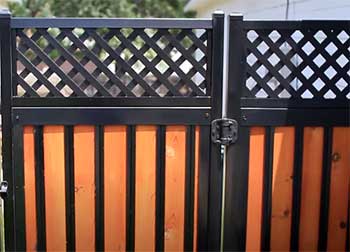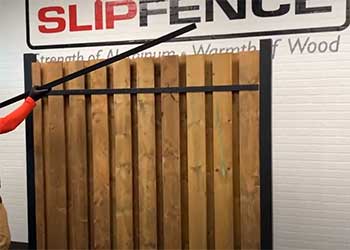So you’re in the market for an invisible dog fence to keep Fido safely in your yard. You’ve narrowed it down to two top options – FenceTrac and Slipfence. But which one is right for you and your pooch?
I’ve done the research to compare these two popular wireless dog fences on all the key factors to consider. Read on for the full rundown on FenceTrac and Slipfence!
A Brief Comparison Table
| Feature | FenceTrac | Slipfence |
| Transmitter | Wireless, no outlet needed | Plug-in, requires outlet |
| Maximum Boundary Radius | 50 feet | 200 feet |
| Total Coverage Area | Up to 1 acre | Up to 2.5 acres |
| Correction Levels | 4 levels | 6 levels |
| Collar Battery Life | 2-3 weeks | 2 weeks |
| Collar Features | Waterproof, rechargeable | Waterproof, rechargeable, LCD display |
| Warranty | 1 year limited | 2 year limited |
| Price | $299 for kit with 500′ wire and 1 collar | $339 for kit with 500′ wire and 1 collar |
What Are FenceTrac and Slipfence?

First let’s make sure we’re all on the same page about what exactly FenceTrac and Slipfence are.
Both are do-it-yourself, wireless dog fence systems that work by burying a wire around your yard to create a boundary.
Your dog wears a special receiver collar that interacts with the buried wire and administers a correction (static shock) if they cross the boundary.
This allows you to set up a “virtual fence” and keep your dog safely contained without installing an actual physical fence. The systems give you adjustable boundary width and multiple correction levels to fit your specific yard and dog’s needs.
FenceTrac and Slipfence operate on the same general wireless dog fence principles. But they have some key differences when it comes to features, installation, cost, and more.
FenceTrac Overview
FenceTrac markets itself as the only completely wireless dog fence system. It uses a transmitter that can be placed anywhere in your home without requiring connection to an outlet. The transmitter sends the boundary signal through your buried wire up to a maximum radius of 50 feet.
Some of the key features and specs of FenceTrac include:
- Completely wireless transmitter with no outlet needed
- Adjustable circular boundary from 5 feet up to 50 feet radius
- Rechargeable collar battery lasts 2-3 weeks
- 4 adjustable static correction levels
- Collar is waterproof and rechargeable
- 500 feet of 20 gauge boundary wire included
- Wire burial depth of 3-6 inches
- 1 year warranty
FenceTrac aims to provide a bit more flexibility and convenience than some competing systems. The ability to place the wireless transmitter anywhere in your home is a major perk, as well as the wide range for adjusting the boundary radius.
Slipfence Overview
Slipfence is also a wireless dog fence focused on convenient DIY installation. But it functions a bit differently than the FenceTrac. Here are some of Slipfence’s notable features:

- Transmitter plugs into outlet
- Adjustable boundary from 5-200 feet radius
- Rechargeable collar battery lasts 2 weeks
- Progressive static correction with 6 levels
- Waterproof and rechargeable collar
- 500 feet of 18 gauge boundary wire included
- Recommended wire burial depth of 4-6 inches
- Wire splices not needed
- 2 year warranty
The transmitter requiring an outlet is less convenient than FenceTrac’s wireless option. However, the potential for a much larger 200 foot boundary radius is a major advantage of Slipfence. Not needing any wire splices to set up the perimeter is also a nice bonus.
Key Differences Between FenceTrac And Slipfence
- Installation and Setup
Installing the physical boundary wire around your yard is essentially the same process for both FenceTrac and Slipfence. You’ll need to spend some time mapping out the path, burying the wire at the proper depth, and avoiding any obstacles.
FenceTrac recommends burying 3-6 inches deep while Slipfence says 4-6 inches. The wireless transmitter placement is where the key differences come in.
FenceTrac – Since the transmitter is wireless, you can simply place this anywhere in your home within 50 feet of where the boundary wire runs. No outlet is required. This gives you a lot of flexibility.
Slipfence – The Slipfence transmitter must be plugged into a standard 120v outlet. This limits placement, as it needs to be within about 100 feet of any part of the buried wire loop. Extension cords can add more length.
For both systems, you’ll also need to set up the base station and synchronize the collars. This process is pretty quick and straightforward following the manuals. Overall installation difficulty is about equal, with FenceTrac perhaps having a slight edge with the flexible wireless transmitter placement.
- Boundary Area and Adjustability
In terms of the size of boundary area you can enclose, Slipfence is the clear winner. Its maximum radius of 200 feet from the transmitter allows you to cover a boundary of up to 2.5 acres. FenceTrac maxes out at a 50 foot radius, so just under 1 acre of coverage.
Both systems provide adjustable boundary widths, letting you set it as narrow as 5 feet. This flexibility is useful for keeping your pet out of garden beds, pools, and other areas without affecting the whole yard.
For containing large yards and properties, Slipfence’s potential for giant boundaries up to 2.5 acres is a major advantage over FenceTrac’s 1 acre max. But FenceTrac offers ample flexibility for most average home lots.
- Correction Levels
The number of adjustable correction levels available is another point of differentiation between the two systems:
- FenceTrac offers 4 static correction levels from mild to more intense. This provides decent flexibility to match your dog’s tolerance and training needs.
- Slipfence has 6 progressive correction levels, starting with an audible tone, then vibration, and finally static corrections of increasing intensity. This wider range of corrections may allow for even gentler training.
While Slipfence wins out again on number of correction settings, both systems should provide sufficient adjustability for appropriate and humane training of your dog.
- Collar Functionality
The collars included with both systems are waterproof for all-weather use and rechargeable to avoid disposable batteries. This type of collar is pretty standard for most modern wireless fences.
FenceTrac claims their collar battery lasts 2-3 weeks per charge. Slipfence advertises a battery life of 2 weeks. For the average user, you can expect to charge about once a month with either.
A nice additional feature with the Slipfence collar is the inclusion of a digital LCD display. This allows you to easily check the correction level, battery status, and training mode. FenceTrac’s collar lacks a display.
Overall, collar functionality is very similar between the two. But the digital display screen on the Slipfence collar is a handy extra.
- Cost Comparison
When it comes to price, here’s how the two systems stack up:
- FenceTrac – Retails for $299 which includes 500 feet of boundary wire, wireless transmitter, and single collar. Extra collars are $99 each.
- Slipfence – Retails at a slightly higher $339 for the same 500 feet of wire and single collar package. Additional Slipfence collars cost $119.
You’re looking at roughly a $40 price difference for the starter kits. Expanding into a multi-dog home adds $20 more per collar for Slipfence versus FenceTrac.
Overall, Slipfence carries about a 10-15% premium over FenceTrac based on retail pricing. FenceTrac gives you a little more value, but Slipfence compensates with some extra features like the bigger coverage capacity.
- Warranty
FenceTrac offers a 1 year limited warranty on the system for defects and malfunctions. Slipfence protects your system for 2 years, so you get an additional year of coverage compared to FenceTrac.
Both should provide sufficient protection against early failure, but Slipfence’s 2 year warranty is more generous.
Frequently Asked Questions (FAQ)
For most homeowners, yes – the Slipfence wireless dog fence delivers worthwhile benefits that make it a valuable investment for keeping your dog safe and secure. The expandable coverage up to 2.5 acres is a major perk compared to competitors, and the system is easy to install as a DIY project. The added warranty length and collar display are also nice bonuses over similar options. Just be prepared to pay a slight premium for the advantages Slipfence offers.
Slipfence is an underground, wireless dog fence system. It uses a transmitter and buried boundary wire to create a circular “virtual fence” up to 200 feet in radius from the transmitter. Dogs wear a special receiver collar that delivers a correction if they cross the wireless fence boundary. This allows you to safely contain pets without installing a traditional fence. The term “slip fence” refers to portability – the boundary can be adjusted or turned off to suit your needs.
Slipfence does not require any fence posts or physical barriers. The boundary is created with a thin gauge electrical wire buried a few inches underground, which communicates with a collar worn by the pet. No fence posts or other materials are needed. The collar provides the “virtual fence” through the buried wire signal.
Installing a Slipfence system involves three primary steps:
1. Mapping out the boundary area and path for the wire.
2. Burying the included boundary wire at the proper depth using a trenching tool or lawn edger.
3. Wire depth should be 4-6 inches.
4. Connecting the transmitter to an outlet and synchronizing the collar to communicate with the buried wire.
Additional steps include configuring the boundary width, testing the system, and training your dog on the new fence. It’s a good DIY project that most homeowners can complete in a few hours or a weekend. Follow all Slipfence’s included directions for optimal installation.
Verdict
Now that we’ve compared these two great wireless dog fences on all the key factors, which is the right choice? Here are some quick takeaways:
- FenceTrac is best if you want maximum convenience and flexibility in transmitter placement, along with slightly more affordable upfront and collar costs. It lacks some of Slipfence’s bells and whistles but provides quality performance at a fair price.
- Slipfence shines if you need to cover the largest possible area up to 2.5 acres. The max 200 foot radius capability bests FenceTrac’s 50 feet. Slipfence also offers extras like the LCD collar, wider correction levels, and longer warranty. But you pay a bit more.
- For typical suburban yard and acreage sizes, either will likely meet your needs just fine. FenceTrac gives you more freedom in positioning the wireless transmitter, while Slipfence allows safely fencing off up to 2.5 acres if needed.
Hopefully this detailed FenceTrac vs Slipfence comparison has provided some clarity to guide your purchasing decision. Both are quality DIY wireless dog fence systems. Choose the FenceTrac for maximum flexibility and value. Or go with Slipfence if you need huge coverage and a few extra perks.
Whichever you choose, you can rest assured your beloved pup will stay safely contained so you both can fully enjoy your outdoor time together!

